The Desktop Kabini Review Part 1: AMD Athlon 5350 (AM1) Tested
by Ian Cutress on April 9, 2014 8:00 AM ESTIGP Comparison, Synthetics
AMD’s graphics stack from top to bottom is all based on the Graphics Core Next architecture. This is an update from earlier VLIW implementations, offering for scalability from low power all the way up to high performance. At the heart of an AMD graphics system is the compute unit comprising of 64 GPU cores. Each compute unit can act independently, ensuring that multiple tasks can complete as quickly as possible due to multiple kernel dispatch across the entire core. In the Kaveri APU launch we were dealing with APUs that contained 6 or 8 compute units for 384/512 cores. With this level of performance, gaming at 1080p30 was possible on most titles depending on how the quality settings were configured. For Kabini, the entire range is given two compute units, with individual processors differing in clock speed.
With two compute units, we are not expecting much from the gaming aspect of these APUs in terms of ‘the latest’ titles. Our benchmarks in the next few pages show that even F1 2013 at 1280x1024 on low settings, unless the engine powering the game is basic, 25 FPS minimum is a hopeful target. This lack of horsepower may limit these APUs to Flash based titles, perhaps even some of the more reasonable Unity games. In AMD’s slide deck they quote games such as Minecraft, Lego Marvel Superheroes and Bastion as the sort of titles that a Kabini player should aim for.
There is some confusion regarding the naming convention of these integrated graphics solutions. Soldered on Kaveri parts designed for all-in-ones, such as the A6-5200, use the HD8000 naming scheme, such as the HD8400. The Athlon 5350 is analogous in design to the A6-5200 except for a 50 MHz speed bump and the name of the IGP – here this is designated as the R3 series. This is despite retailers who are currently selling this APUs and labeling them with the HD8000 designations.
Like Kaveri, the integrated graphics solution in Kabini features an updated Video Codec Engine and Unified Video Decoder giving hardware support for H.264.
AMD is also promoting their Picture Perfect solution, using additional post processing tools to increase video quality on the fly:
Also rather interestingly AMD is claiming an enhanced decoder for JPEG files. Given that one of the primary uses for a Kabini system might be for web access where JPEGs are standard, AMD has been promoting up to a 2x performance increase over a J2900 system:
AMD’s secret sauce, according to their slides, appears to be heterogeneous computing. This would be the ideal usage scenario for computing going forward.
GPU Synthetics
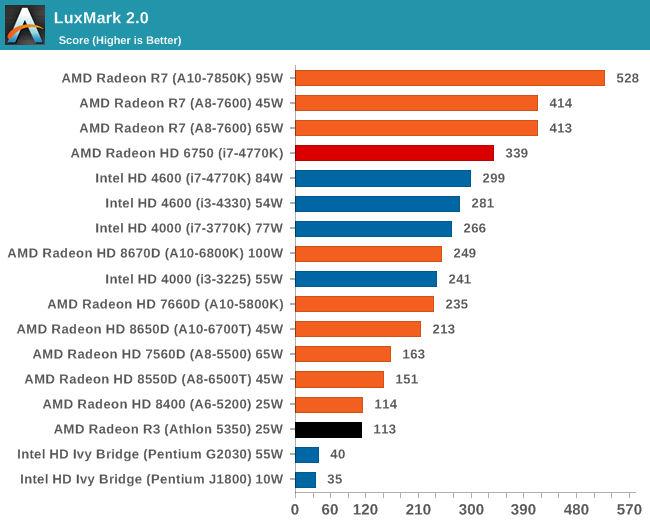
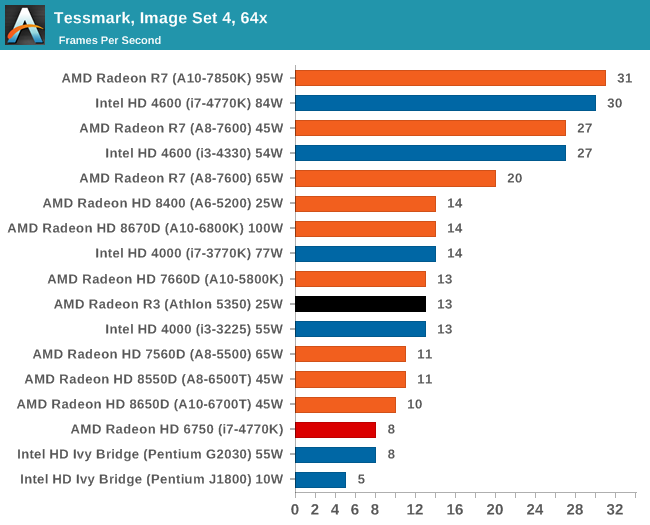


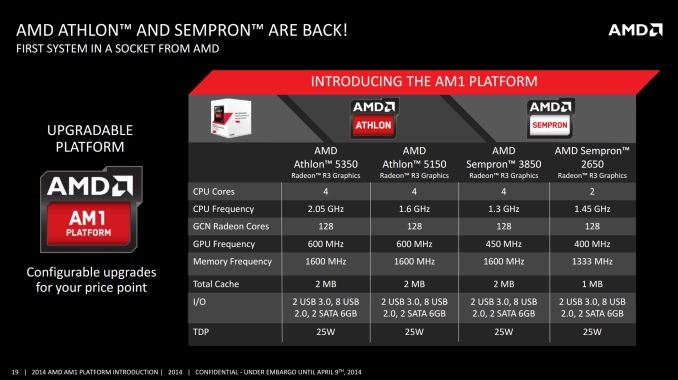
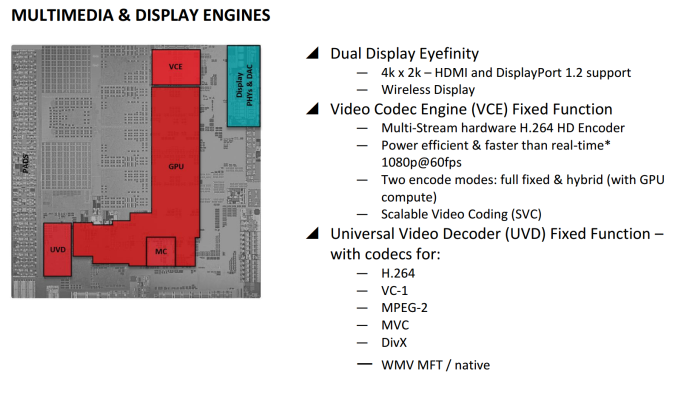
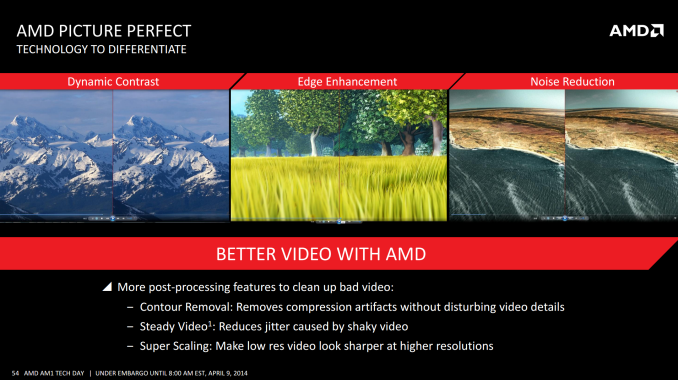
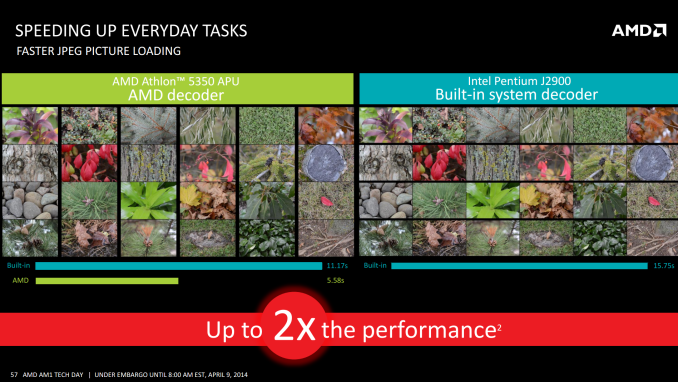
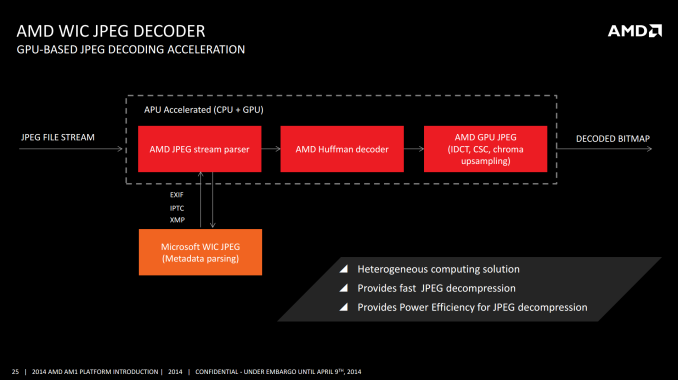








126 Comments
View All Comments
Shivansps - Wednesday, April 9, 2014 - link
J1900 is quad, J1800 is dual.Anadtech did everything they could to make the 5350 look good, not incluiding Haswells is one giant red flag right there, the 5350 MUST be tested vs G1820 as well J1900 and AMD A4s, none of those tests where done to make the 5350 look good.
YuLeven - Wednesday, April 9, 2014 - link
But, but, but... but... G1820's power comsumption is a solid 25W more! Think of the dolphins and the trees! It must be rubbish!Communism - Wednesday, April 9, 2014 - link
The funny part is that the G1820's true TDP isn't anywhere near 55w.It's only listed as 55w TDP because Intel doesn't want to make selling their more expensive low power parts even harder :P.
Communism - Wednesday, April 9, 2014 - link
To put this in perspective, my 3570k supposedly has a TDP of 77w.It actually does about 70w for the CPU alone @ 4.4ghz running Intel Math Library Linpack (The highest heat output you're likely to ever see).
That was running just 5-10 degrees from TJmax as well, so superior cooling wasn't a large factor since the stock CPU w/ stock cooler @ stock speeds would be about that temperature as well.
jospoortvliet - Thursday, April 10, 2014 - link
Esp as it turns out that power usage compared to jaguar cores is barely a few percent lower and actually muc worse at idle. The final article will have to come back on this statement.riottime - Wednesday, April 9, 2014 - link
gosh. it's depressing looking at the stale fx line in that roadmap. :(FriendlyUser - Wednesday, April 9, 2014 - link
Great product! Ideal for an HTPC or NAS or even a casual desktop. It will be a hit in the weaker economies.Ranari - Wednesday, April 9, 2014 - link
It's a great product for the price, and that's all it needs to be: Quad core, a powerful and compute-capable GPU, and reasonably feature rich. The only thing that seems to be holding the Cat cores back are their clockspeeds.robbertbobbertson - Wednesday, April 9, 2014 - link
mini-PCIe slot cannot be used for cooking scrumptious bacon pancakesi am disappoint
QChronoD - Wednesday, April 9, 2014 - link
Just wanted to point out that the description of the IGP Gaming page says the tests are being done at 1080P and Xtreme settings, but it lists 1280x1024 on the graphs. Are they being done at the highest settings as well? I would imagine the test would be more useful if the settings were turned down to medium or low since that's what anyone with the system would actually be using.